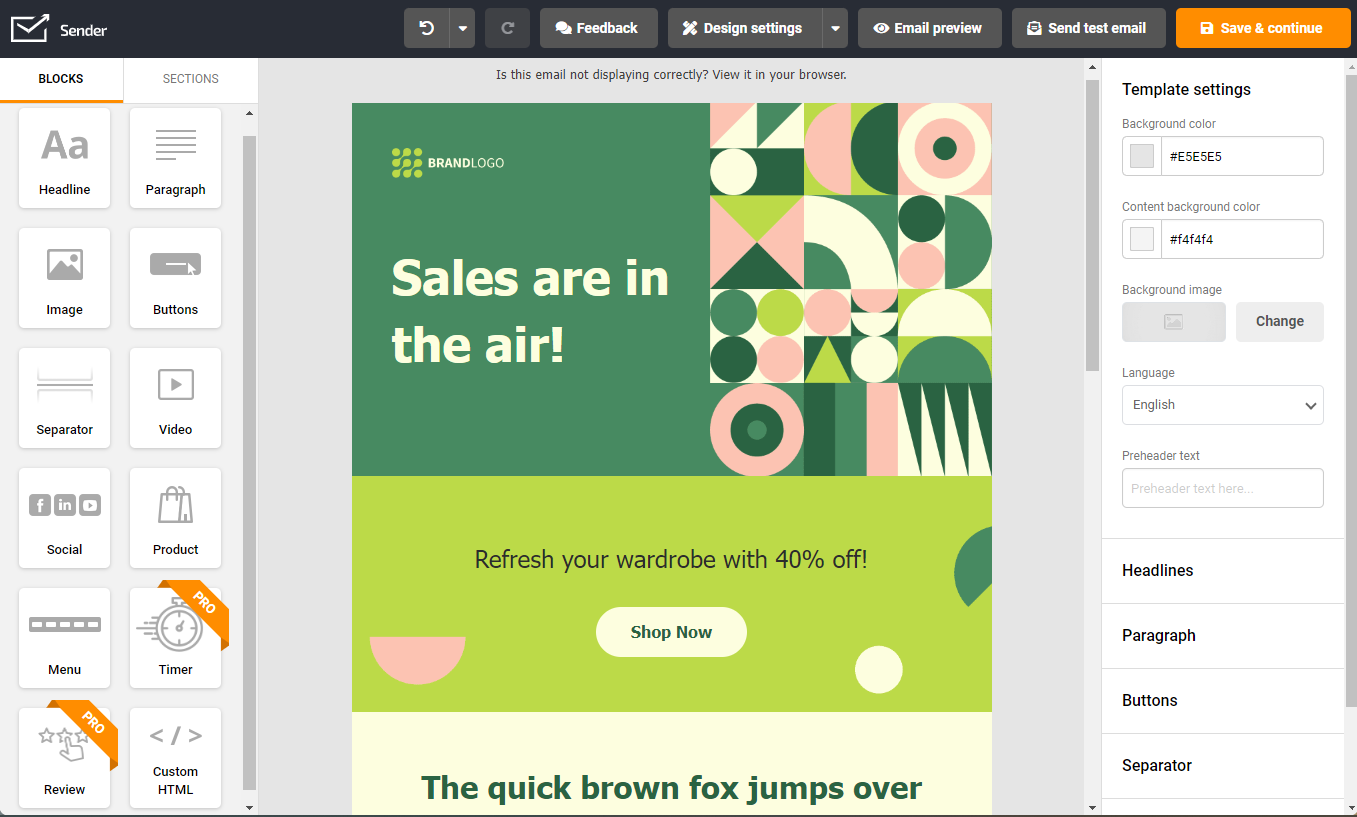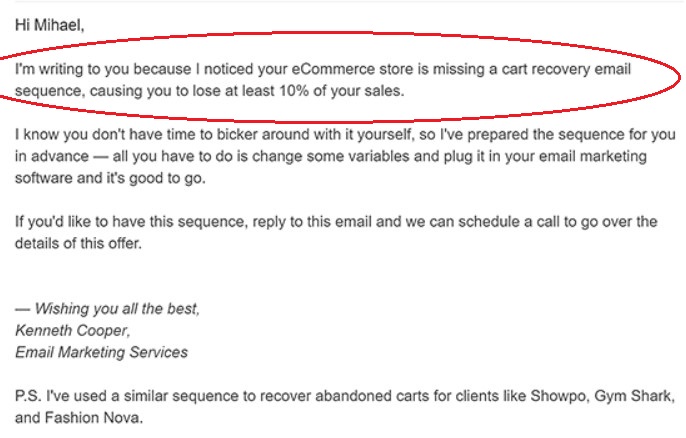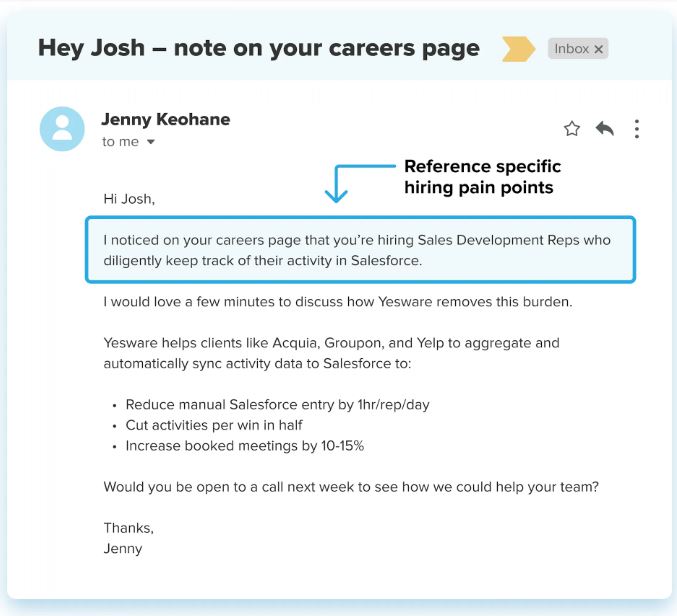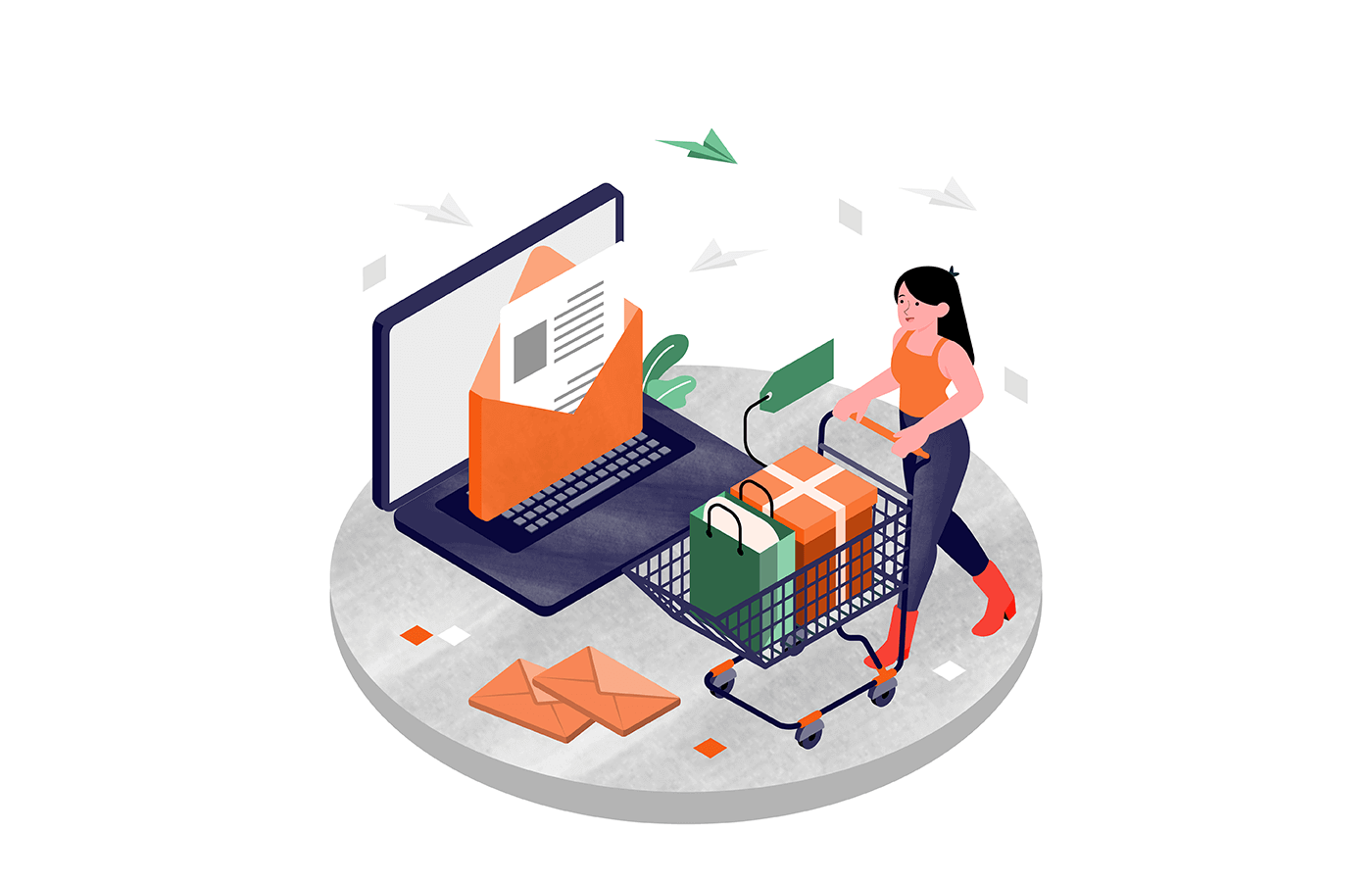Statistics show that, on average, individuals receive about 150 emails daily and promptly delete around half of them.
So, what can you do? What strategies can you use to create a sales email that encourages recipients to both open and reply?
This article will discuss the basics of composing a sales email, provide examples of effective sales email templates, and offer ways to evaluate its effectiveness.
What is a Sales Email?
A sales email is a type of email that companies use to advertise their products/services to potential customers and existing clients. It is used for direct marketing purposes, usually to drive sales.
Well-written sales emails contain vital details about the company, its offerings, the sales procedure, pricing, and contact information. The effectiveness of an email is determined by the value of the offer inside it, the subscriber’s engagement with the brand, and the persuasiveness of the content.
Why Sales Email Matters?
8 out of 10 customers prefer to be contacted via email. Here are the top reasons that highlight the benefits of sending sales emails:
- Email marketing has a massive reach. Anyone who is online typically has an active email address;
- Email is a proven way to ensure your message gets delivered to your targeted audience;
- Sales emails can bring in a high ROI. On average, every dollar spent on email marketing produces $36 in profitability;
- Sales emails help to forge stronger customer relationships by delivering helpful information;
- A sales email can help to build authority and establish your business as an expert in the industry.
How to Write Sales Emails?
Now this brings us to our next question – how to start a sales email?
There are many different kinds of sales emails, such as welcome emails, cold reach emails, follow-up emails, and more. But remember, a good sales email structure follows a clear path, includes relatable content, and encourages the readers to take action.
Here are four common attributes you must pay attention to when writing a sales email:
- Make it persuasive. Your email has to stand out to grab your reader’s interest. This starts right from a compelling subject line and stays relevant throughout the body. Use compelling phrases that motivate the readers to take action;
- Keep it short and simple. Nobody likes reading long emails, especially from someone trying to sell them something. Keep your sales email short and relevant;
- Include clear CTAs.Whether you want your prospect to schedule a demo call, get valuable information, or make a purchase, include clear calls-to-action throughout the email body;
- Make it valuable. In your sales emails, take a consultative selling approach to offer valuable information to your prospects and address their pain points. This will help build trust and ultimately lead to a sale.
Looking for an easy-to-use email marketing software to craft stunning emails in bulk? Sender’s here to do the job for you.

8 Crucial Parts of the Best Sales Emails
Every sales email may look completely different, but it generally includes certain vital components that define its efficacy.
1. Use Engaging Sales Email Subject Lines
Did you know that 69% of email recipients report an email as spam simply based on their subject lines?
Without an evocative sales email subject line, your email is seldom going to get opened. Make your subject lines interesting, straightforward, and to the point.
Example:
Bad email subject line: Hotel ABC September Newsletter
Good email subject line: Handy travel tips from Hotel ABC
Moving on, here are some good practices to consider when crafting a subject line for your sales email:
- Make it personalized
- Keep it short
- Don’t bury the lead
- Use action language
- Include numbers
- Don’t use clickbait
- Think through emojis
- Make it readable
- Avoid shouting
- Test, test, test
2. Write Nongeneric Opening Lines
If you want your prospects to read your sales email, always start with an impressive and intriguing opening line. Ditch the generic – “Hi, my name is…”
Instead, start by directly addressing the recipient with something more impactful. Here are some ideas you can use for your sales email templates:
- I loved your post on …
- Congratulations on …
- I recently noticed that you …
- [Mutual Connection] referred …
- I saw that we both …
Here is an example of an opening line that hooks the recipient from the very start:

3. Adjust the Length of the Email Body to Suit Your Audience
Marketers believe that an email body length that is between 50 and 125 words is ideal. Statistics also reveal that an email body between 25 and 50 words results in over 50% higher response rates. So don’t load your sales email with lots of text — keep it simple and brief.
4. Do Not Talk About Yourself
Several marketers make the mistake of leading an email by praising themselves, their business, and its offerings. Such sales emails can quickly put off readers and end up in the trash folder.
Instead, focus on the benefits and results that your prospects can expect from your product/service. Mention how it can address their pain points and improve their situation. This will help to create a mutual connection. Also, while writing sales emails, provide quantifiable examples, case study links, and testimonials to back up your claims and establish authority.
5. Ensure to Send Emails at the Right Time
Emails received at an inappropriate time are often forgotten or buried in the inbox. Therefore, sending emails at optimum times can boost the open rate significantly. It can also lead to better click-through rates and increased target audience reach.
6. Personalize Emails
Your prospect’s inbox receives hundreds of generic emails every month. Stand out by personalizing your emails and building rapport with your potential customers. After all, personalized emails deliver six times higher transaction rates.
Here are three simple ways how you can personalize your sales email templates:
- Include relevant information about the prospect in the email. Use email marketing tools like Sender to analyze customer data and create segmented email campaigns;
- Demonstrate how your product/service can benefit every prospect;
- Offer successful case studies or other social proof.
Here is an excellent example of a personalized sales email sent after an initial prospect call:

7. Keep It Simple
Nobody has the time to read long and overly complicated messages. Keep your sales email simple, concise, and easy to digest with a clear call to action. Avoid jargon or unwanted details that might bore prospects. Don’t forget to proofread your email for grammar, tone, and spelling.
Additionally, end every sales email with a neat email signature to boost brand recognition.
8. Send a Follow-Up Email
There is a high chance that you won’t get a response from a cold prospect after the first email. Sending follow-up emails is important to keep the conversation going.
Personalize your follow-up email to enhance its value. Try adding something that might interest the recipient, such as a recent industry report, a relevant blog post, or a similar resource.
Effective Sales Email Templates
Here, we will look at some of the most popular and thoughtfully crafted sales email templates. These templates can be used for various scenarios and sales cycle stages. Use them as a helpful starting point to craft convincing emails that generate sales.
1. Cold Outreach Email Template
An unsolicited email to a prospective customer whom your business has not interacted with before is a cold outreach email. This initial sales email is being sent to start a conversation with a prospect who has shown interest in your product or service or may benefit from it.
The main goal of cold sales emails is to form a real bond with the prospects by understanding their requirements. Sales emails like these usually stand out by providing personalization and unique value to the recipient, helping you cut through the noise.
Subject line: Quickest Fix for your [Pain Poin]
Hi [Recipient’s First Name]
I came across your [social media post] and noticed that your business might be struggling with [specific pain point].
I’m [Your Name], and I work at [Company Name]. We help businesses like yours to overcome those business challenges with [explanation of your solution]. Our product/service can help you [mention notable benefits or outcomes of your product/service].
I’d love to chat and figure out a way to help your business achieve [desired outcome].
Are you free for a quick call next week? Let me know your availability, and I’ll be happy to schedule something.
Looking forward to hearing from you,
[Your Name]
[Your Contact Number]
2. Follow-Up Email Template
A follow-up email is sent to someone you have contacted before. Unlike a cold email, this is sent to existing customers and comes after a preliminary interaction or when you have built a rapport with the recipient.
These emails can be sent at significant points in the sales funnel to collect important information or remind the recipient to take action.
Subject line: Hey [Recipient’s Name], looking for more information?
Hi [Recipient’s First Name]
Thanks for visiting our website!
Just a gentle follow-up to my last email: Have you had the chance to consider my proposal? I’d be happy to go over it over the phone or email and address any additional queries that you may have.
When are you available for a quick conversation?
Looking forward to hearing from you,
[Your Name]
[Your Contact Number]
Interested in this type of sales emails in particular? Check out 20+ follow-up email examples & how to write a good template.
3. Onboarding Email Template
An onboarding email marks the initial contact with the customer following their purchase or registration for your product or service. Creating a successful onboarding email is essential for getting new customers involved and boosting their lifetime worth.
Each onboarding email from a business will contain different components based on their specific customer experience.
Nevertheless, every onboarding email includes certain fundamental elements like a greeting message, information on how your product/service will benefit them, and guidance on what to anticipate throughout the onboarding process.
Subject line: Welcome to the [Company Name] family
Hi [Recipient’s First Name]
Thanks for purchasing from [Company Name]. We’re glad to have you here.
We developed this product to assist individuals [Product Value Proposition], and we are pleased to welcome you on board.
We will send you the materials you need to begin using [Product] in the coming days and follow up with you to monitor your progress.
Feel free to contact me if you have any questions.
Excited to welcome you to the [Company Name] family!
Best regards,
[Your Name]
4. Post-Meeting Email Template
After a successful initial meeting with a potential client, you will likely want to send them a follow-up email. These types of emails can greatly contribute to establishing strong connections with potential clients.
Subject line: Are you ready to take the next step?
Hi [Recipient’s First Name]
Thank you for your time yesterday. Discussing [topic or issue related to your product/service] was a wonderful experience. As previously stated, [Your Company Name] focuses on [brief description of solution].
I would like to share a [relevant blog piece/case study] that showcases how we have helped businesses like yours achieve impressive results.
I am free for a phone call this week if you’d like to discuss more.
Looking forward to hearing from you,
[Your Name]
[Your Contact Number]
5. Car Sales Email Template
Car sales emails are a type of cold email sent as a part of your marketing and communication strategy to capture a prospect’s interest.
These emails provide an opportunity for you to present yourself, your automobile dealership, and your car inventory. They are intricately designed to attract potential customers, nurture them, and ultimately close more deals.
Subject line: Welcome to [Car Dealership’s Name], [Recipient’s Name]!
Hi [Recipient’s First Name]
I am glad your car search has led you to our website, and I look forward to providing you with whatever information you may require.
Our wide selection of vehicles and knowledgeable team are prepared to assist you in a smooth car-buying journey.
Please inform me of your availability so we can schedule a meeting to talk about your needs and explore our inventory.
Looking forward to hearing from you,
[Your Name]
[Your Contact Number]
6. B2B Sales Email Template
Sales reps send these sales emails to B2B companies to promote their products or services. These are quite like cold emails, as they are sent to business professionals who have had no previous interaction with your company.
These B2B emails provide a cost-effective and efficient method for gaining insights into potential clients and creating new business opportunities.
Subject line: Grow Your Business with [Your Product/Service] – Let’s Discuss!
Hi [Recipient’s First Name]
I noticed that you recently downloaded a whitepaper about [Issue]. I’m [Your Name] from [Your Company Name], and I think that [Your Product/Service] might be a perfect fit for [Prospect’s Company].
We’ve helped several companies like yours grow with:
– A Solution
– B Solution
– C Solution
If you’d like to learn how [Your Company] can help you reach your business goals, feel free to book a consultation call with us here. [Calendar link].
Looking forward to hearing from you,
[Your Name]
[Your Contact Number]
7. Outbound Sales Email Template
Sales professionals send outbound sales emails to cold prospects to familiarize them with your product/service and build a rapport with them. These emails typically follow a consistent structure for communicating valuable information, offers, and updates.
Subject line: Ready to Meet Your New Favorite Thing?
Hi [Recipient’s First Name]
At [Your Company Name], we just launched something we think you’ll love: [Product Name]. Easy to use, effective, and could be just what you’re looking for!
If offers [brief explanation of its benefits or the pain point it addresses].
Interested? Click here to get yours today [link to the product page].
Best regards,
[Your Name]
[Your Contact Number]
8. Introductory Sales Email Template
A sales introduction email is the message you send to a prospective customer to introduce yourself, your business, its offerings or sales process. It may be your first attempt at connecting with someone who may be interested in what you offer.
This sales email aims to grab the recipient’s attention, offer value, and persuade them to take a specific action, such as scheduling an appointment or making a purchase.
Subject line: Your work in the [Prospect’s Industry] caught my eye.
Hi [Recipient’s First Name]
I am [Your Name] from [Company Name]. We specialize in [Your specialization] with a focus on [Brief description of your expertise].
I recently came across your blog post on [Topic] and found it extremely insightful. I believe we both care about [Shared goal] and could work together to achieve [Desired outcome].
Would you like to discuss this further? I’d be delighted to share insights into my projects and learn more about your business.
Are you free for a quick call next week? Let me know your availability, and I’ll be happy to schedule something.
Looking forward to hearing from you,
[Your Name]
[Your Contact Number]
How to Check if Your Sales Emails are Working?
The most effective way to check if your sales emails are working is to track them. If you are using a CRM tool to automate sales emails, you can easily monitor specific metrics to determine the efficacy of your emails.
Additionally, statistical techniques such as mix media modeling (MMM) can be used to measure the impact of your sales emails. Examining some helpful sales email examples can also help to determine if your emails are lacking critical points.
Here are the top metrics to evaluate:
- Email open rate. Open rate tells you the percentage of recipients that have opened your sales email. It is a brilliant indicator of email deliverability, performance, and subscriber engagement;
- Evaluating the click-through rate. The percentage of people who click to visit your website from a promotional email is indicated by the click-through rate. It takes into account individuals who read your email and reply, making it a more precise indicator of engagement;
- Analyzing response time. This metric evaluates the time it takes for a customer or prospect to respond to a sales email. Shorter response times often correlate with greater customer engagement and satisfaction;
- Gathering A/B testing results. A/B testing is a very successful way to evaluate the efficiency of sales emails. It is possible to perform A/B testing on different parts of the sales email, including subject lines, opening lines, and email length, and then make changes according to the results;
- Tracking unsubscribe rates. The percentage of recipients who remove themselves from your email list after viewing your sales email is known as the unsubscribe rate. A large number of people choosing to unsubscribe may suggest that your content is not appropriate or that you are overloading potential customers with numerous emails.



